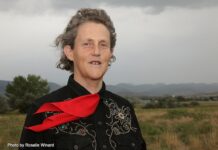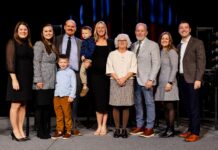ENON VALLEY, Pa. — Last summer, when Don Kenny visited his cardiologist for a routine check of his enlarged heart, the specialist told him he’d see him in a year.
That was good news for the 52-year-old western Pennsylvania farmer who was busy making changes in his dairy operation and looking forward to working with his son full time.
Instead, a tragic set of circumstances in August 2010 would change the farm forever.
Bob Kenny, Don’s father, said Don was moving cattle that August day when a couple of employees noticed something was off: The cattle were moved, but the gates weren’t closed. They went to investigate and found Don. His heart had stopped and he was gone.
* * *
Don had been working with the local conservation district and the USDA Natural Resources Conservation Service to convert what had been traditional crop land into pasture land. He began looking at a managed grazing system in 2009 and had just put the plan into action.
Don had been a partner in the farm with his parents, Bob and Alma. At one time, they were milking 400 head, but had recently sold half of the herd, shifting gears to an intensive grazing system. Don’s son, Clayton, had just returned to work on the farm full-time.
History
Bob Kenny went to work on a farm with his new bride, Alma, in 1952. They started out working for a salary and later worked for shares in the farm. Eventually, the couple purchased the farm, equipment and the cattle.
“All I knew was Holsteins and Farmalls when I came here. It was all new to me. It was Jersey cattle and Allis Chalmers tractors,” said Bob.
The family raised corn and alfalfa to feed their dairy animals for years. Bob said that was just how it was done.
They had added cattle over the years and been successful in their operation. But the high grain prices in 2009 had Bob thinking that something needed to change. The family knew they wanted to stay in the dairy business, even when the milk prices fell, and they knew they wanted the next generation to be a part of it.
Bob said Don knew that if a switch wasn’t made, the farm might not make it to the third generation.
* * *
After Don’s death, Bob and Clayton were left with difficult decisions to make. The farm was in the middle of the grazing transition, and now had an estate to settle. They decided immediately to continue where Don had left off, continuing the grazing plan.
“It gave us a way to be very flexible,” said Clayton. “If the milk prices crash like they did in 2009, we can just turn the cattle out and lower our feed costs.”
New system
They continued building fencelines, and installing waterlines, frost-free hydrants and an animal lane.
Pressurized waterlines were installed, which included 2 1/2 inch lines and 1 1/2 inch lines depending on how far out the lines had to reach. They are fed from the well on the farm because it provides a more dependable system than springs, the Kennys say.
There are 20 frost-free hydrants, and 100-gallon water tubs placed in paddocks that can be moved to where they are needed so the Jerseys can obtain the water they need.
Paddocks
The fencelines were built to create a series of paddocks where the cattle would graze. Each paddock was created so that they can be equal in size, utilizing the non-permanent fencing.
The grazing system has a permanent perimeter fence. Everything else is movable.
Clayton said it provides flexibility depending on the number of cattle, weather and grass condition.
In addition, animal lanes were created. They are stabilized walkways where cattle travel to the individual paddocks. Some of them gathered water, so a textile fabric was laid on top followed by large stone and finished off with a smaller stone to ensure they stayed dry and movable.
Learning curve
Clayton said there is definitely a learning curve to the grass-based system, but now in its second year, he can see the benefits more clearly.
Bob said one of the things the farm had to learn about was what type of grasses to plant for the cattle. Currently, there is a mix of Italian rye grass, clover and some orchard grass. The farm has learned that the Italian rye grass grows better in cooler weather and that the cows don’t care for the orchard grass.
Even after raising dairy cattle all of his life, Bob says there is still more to learn about grazing.
“We’re definitely still learning how this all works,” said Bob.
Jerry DiDesiderio, Natural Resources Conservation Services in Mercer, Pa., helped designed the grazing system, and agrees it will always be a work in progress.
“The key is managing the grass,” said DiDesiderio.
“You want them to eat the tops. The stems don’t have the nutrients they need,” said Clayton.
He added that once you have a handle on grass management, then it gets easier. He said that even with the dry summer, the farm always had plenty of green grass.
Haylage
In some pastures where the grass got ahead of the grazing herd, the farm made haylage from it. Clayton said it measured 17 percent protein and was testing higher than the farm’s alfalfa.
Clayton said the key has been keeping milk production up and trying to contain input costs.
Ration
The farm is still providing a total mixed ration designed by a nutritionist at Witmer’s Feed and Grain, but what goes into the mix depends on the grass condition.
“Our end goal is to reduce feed costs,” said Clayton. “Good management is critical.”
“We just keep plugging away,” said Clayton.
Clayton said if it is raining, the Jerseys are kept inside the barn longer, and the ration has to be adjusted to ensure the cattle are getting enough dry matter so that production doesn’t fall.
“Everything is a factor,” said Clayton.
Trick of the trade
One trick the operation has learned is to remove the ration about an hour before the cows are put out.
“If you let them get a little hungry, they eat when they go out. Otherwise, they would just be laying there,” said Clayton.
Now, the cattle go for the fresh grass that has not been touched in a few days when turned out into a paddock.
“They are your harvester and your manure spreader all in one,” said Clayton.
Other benefits the Kennys have noticed include lower veterinary bills, less hoof and bloat problems, and a lower somatic cell count.
“We still have a sick pen ready, but the difference after going to grazing is that no one is in it,” said Bob.
He said he has been surprised by how much the somatic cell count has dropped, the low incidence of mastitis and how much better the condition of the feet on the cattle are in.
Bob talked about his son, Don, and how he made his own mark on the farm over the years, and how Don enjoyed working with the cattle.
He stopped as he looked out over the pastures, and pointed out the pastures in front that were definitely Don’s work. A generation may not be there any longer, but the link that Don inspired is holding the generations together on the farm.
* * *
To read more about the family and their lives, visit this post on our blog, The Social Silo.










A sad but positive story. That tragedy is where too many of America’s family farms end. Thanks to the Kenny family for sharing this story of farm-family perserverance. The family farm will remains as a tribute to their son/dad, Don. May God bless them for years to come.
Frank Gasperini
Nice job Kristy. What a great family.
Wow! These folks are to be commended. You are truly the heart of America. Keep up the good work.